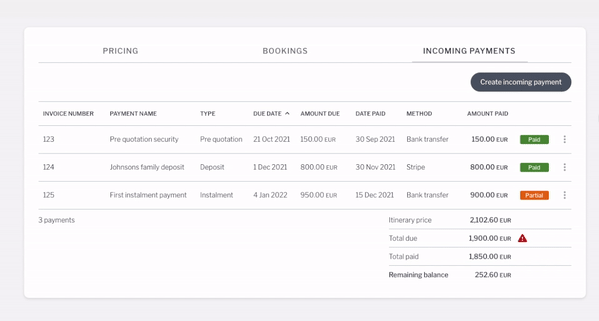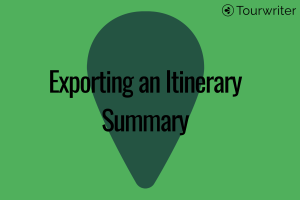Incoming Payments
The General payments subtab allows Users to create and manage Incoming payments. Creating an incoming payment allows customers to keep track of mulitple payments for an itinerary and can be used to create exportable Invoice PDF’s. Updating an Incoming payment with an Amount paid ensures you reconcile your Amounts due and means you can export payment information as Receipt PDF’s.
Incoming payments ensures Tourwriter customers can manage and report on traveller payments and is an important section for customers accepting payments via the Stripe integration method. The Incoming payment functionality also introduces features such as adding an optional invoice number, choosing the itinerary’s travellers or agents as payers, entering a payment amount over and above the itinerary price, entering the due date for the payment and the Payments timeline feature.
Payment types
The following Payment types are available in the dropdown when creating an Incoming payment:
- Pre quotation: Pre quotation can be thought of as a getting started fee. You may charge a traveller a pre-quotation charge before you begin work on the itinerary.
- Deposit: An upfront payment before the sale is completed. It is often used as security and as a commitment from the traveller.
- Instalment: Record an instalment payment if the traveller agrees to pay the total of the itinerary cost in small portions at regular intervals.
- Final: The balance payment in the series of payments. If the traveller wishes to pay the entire itinerary amount at once, you can record it as a final payment.
- Credit: A credit can be used to record a refund to the traveller or to offset any payment recorded. You may also want to record a credit if you have redeemed a credit voucher or incentive of any kind. When you choose a credit payment, the credit amount is displayed as a negative number as it is an amount that you ‘pay out’ to your customer instead of receiving any funds.
Method
The following payment Methods are available in the dropdown when creating an Incoming payment:
- Bank transfer
- Credit card
- Cash
- Cheque
- Voucher
- Stripe: For the Stipe payment to be successful you need to select this Method. Read more here
- PayPal
- Other
Creating an Incoming payment
The total itinerary price carries through to the Incoming Payments sub-tab. You can record payments from travellers for each itinerary. To Create incoming payment:
After adding booking items to the itinerary, the itinerary pricing overview displays itemised pricing in the Pricing sub-tab in the Manage section. The total itinerary price carries through to the Incoming Payments sub-tab.
- In an itinerary, head to the Payments tab and the General Payments sub-tab.
- Select Create incoming payment on the top-right corner to open the Incoming payment window.
- Enter an appropriate name for the payment in the Payment name field.
- Choose a relevant payment type.
- Adjust the Amount Due. When you make your first payment, the outstanding itinerary price defaults as the Payment amount. Subsequently, the Payment amount is adjusted to reconcile the itinerary price. Else, if the total paid exceeds the itinerary price, the payment type changes to Credit and the field displays as Credit amount with a negative value.
- Enter a payment due date.
- Select a payment method. You can choose from Bank transfer, Credit card, Cash, cheque, Voucher, Stripe, PayPal and Other.
- You may enter an optional invoice number. The Invoice number is a free form text field. You can enter the transaction number/invoice number from your accounting tool to ensure the pricing details in Tourwriter matches that in your accounting tool.
- Add Billing information.
- Select Save to create the Incoming payment
Note: For customers wishing to export an Invoice PDF you should do this after saving and before recording an Amount paid. Once a payment is recorded you can only export a Receipt PDF.
Recording a payment from a traveller
You can record payments from travellers against a previously created Incoming payment or add the Amount paid as you are creating the Incoming payment. To record an Amount paid:
- Create an Incoming payment or Edit an existing Incoming payment by clicking the More navigation
- Add a payer to the Payer field. If the traveller is added to the itinerary, the traveller name is shown as an auto-complete suggestion when you click the field.
- Enter the amount paid, for the actual funds that you have received
- Select the date the payment is made in the Date paid field.
- You may enter an optional note concerning the payment in the Add a payment note field.
- Select Save to finalise the payment.

Traveller payments are automatically locked
If you change any traveller payment to the status “Paid,” then the payment is automatically locked. To unlock and edit a locked payment:
- Click the More options icon you would like to Unlock and click Unlock.
- The Payment line is now unlocked.
- Click the More options icon and click Edit or Lock to relock the Payment line
Understanding the payment status
Each payment recorded in the payment table lets you uniquely identify them based on their colour code. Let’s take a look at what each colour represents:
- Red -> Overdue: A red Overdue label denotes that the payment due date has passed and the total amount is not reconciled.
- Orange -> Partial: An orange Partial label denotes that a partial payment was made before the due date.
- Green -> Paid: A green Paid label denotes a reconciled payment.
- Purple -> Overpaid: A purple Overpaid label denotes that the amount paid is greater than the amount due.
- Blue -> Credit: A blue Credit label denotes that you owe a payment to the traveller or that you have offset a payment with a credit.
Note: You can Show payments timeline on the Itinerary preview tab. Please read the help file on this here.
General payments pricing summary
All recorded payments are displayed in the Incoming Payments section in a tabular format. A summary of all the Itinerary pricing totals are shown below any Incoming payments and auto-calculates balances based on the payment entries. The columns in the payment summary include:
- Itinerary price: It carries across from the Total price field on the Pricing page.
- Total amount: It defaults to the itinerary gross price. However, when recording additional payments, it calculates as the sum of the Payment amount for all entries in the payment table. You can record payments on top of the ones that reconcile the itinerary price. For example, including a cancellation fee for last-minute cancellations. Or when recording a pre quotation payment, which you may charge before designing the itinerary (this might also be known as planning fee or handling fee). In such situations, you can override the payment amount with a custom amount, disregarding the itinerary price. And that’s how the Total amount is different from the itinerary price.
- Total paid: The sum of the Amount Paid for all payment entries.
- Remaining balance: Calculates as the difference between the Itinerary price and Total paid. The amount can be a negative value.
Note: The Total amount label alerts you with a red warning symbol for one of the following situations:
-
- The sum of values in Amount paid fields is less than the total Itinerary price.
- The sum of values in Amount paid fields is more than the total Itinerary price.
The warning message is shown as a tooltip, meaning you can read the warning message when you hover the mouse pointer over the warning message. See below.
Payment rules
Payments recorded in the Incoming Payments section are displayed as per the following rules:
- The payments default to an order of ascending due date, meaning the payments due earlier is displayed at the top. You may change the payment order by clicking any other column header. An upwards arrow beside the column header denotes the sort order.
- The payment function lets you make multiple Stripe payments in Tourwriter. See Receive deposit payments with the Stripe integration for details.
- When you do not have an Agency added to the itinerary, the Remaining balance field is calculated as the difference between the Total paid and Total Itinerary price.
- When an agency is added to an itinerary and is set up with one of the following agency commission types: Agency adds markup themselves, Overwrite supplier markup, Calculate commission on top of gross, the primary set up in the Incoming Payments section displays as per the following rules:
- The Total amount field is the same as the Agency price from the Pricing section.
- The Remaining balance field is calculated as the difference between the Agency price and Total paid.
Agency commission override
To reconcile a remaining balance when Agency commission type is Calculate commission from gross, you may need to Override the Incoming payments logic to Use itinerary agent price
- When an agency is added to an itinerary and is set up with one of the following agency commission types: Calculate commission from gross, the primary set up in the Incoming Payments section displays as per the following rules:
- The Total amount field is the same as the itinerary gross price from the Pricing section.
- The Remaining balance field is calculated as the difference between the itinerary gross price and Total paid.
- To override this select Use itinerary agent price from the Override dropdown.
- There is no option to delete a payment record or edit the pricing for a payment record as payments recorded in Tourwriter are effectively a transcript of your bank transactions. If you need to offset or increase a payment record we recommend that you add a credit or additional payment with relevant notes.
 Previous Post
Previous Post Next Post
Next Post






